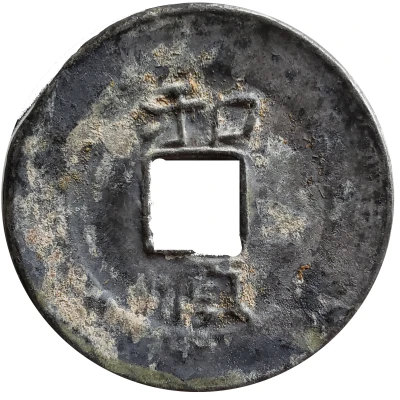


© Micheal Linke
1 Cash - Dagang Heshun Kongsi republics ND
| Lead (Tin, lead, pewter) | 7.29 g | 31.5 mm |
| Issuer | Kongsi Federation (Indonesian States) |
|---|---|
| Type | Standard circulation coin |
| Years | 1776-1854 |
| Value | 1 Cash |
| Composition | Lead (Tin, lead, pewter) |
| Weight | 7.29 g |
| Diameter | 31.5 mm |
| Thickness | 2.5 mm |
| Shape | Round with a square hole |
| Orientation | Medal alignment ↑↑ |
| Demonetized | 1854 |
| Updated | 2024-10-05 |
| Numista | N#283065 |
|---|---|
| Rarity index | 97% |
Reverse
Two Chinese characters at the 12 o'clock and 6 o'clock positions
Script: Chinese (traditional, regular script)
Lettering:
和
順
Unabridged legend: He Shun
Translation: (of the) Heshun
Edge
Plain
Comment
The Chinese characters on the coins display a considerable degree of variation and many subtypes exist. The Catalogue of Coins in the Ethnographical Museum lists 33 gongsi coins, and other varieties continue to turn up.The Fosjoen (Heshun) Federation was formed in 1776 when fourteen smaller gongsis from around Monterado in southwestern Borneo united into a single federation. The federation's leading members were the Samtiaokioe Gongsi, which controlled mining sites to the north of Monterado, and the Thaikong Gongsi, which controlled sites to the west and southwest of Monterado.
After several internal conflicts the Dagang Gongsi eventually rose to supremacy. However, after several wars to maintain its independence, the Heshun Gongsi Federation ended with the surrender of the Da Gang Gongsi to the Dutch in July, 1854. After the surrender the majority of the gongsi cash were melted down.
A paper which covers the Gongsi of southwestern Borneo has been published in the Numismatic Chronicle 1993, pp.171-196, and a hitherto unknown piece has been described in the Newsletter no. 143, p. 15-16, 1995 of the Oriental Numismatic Society by Dr.T.D.Yih.
https://en.m.wikipedia.org/wiki/Kongsi_republic
Interesting fact
One interesting fact about this coin is that it was made of a unique material called "Tin, lead, pewter" which is a combination of tin, lead, and pewter. This material was commonly used in the production of coins during that time period, but it's not commonly used today.